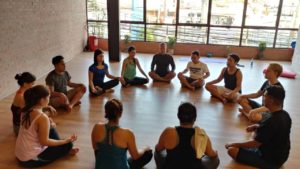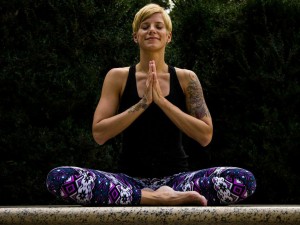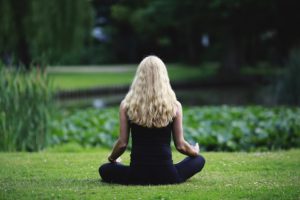 Learn about meditation’s benefits and easy ways to start a practice during quarantine!
Learn about meditation’s benefits and easy ways to start a practice during quarantine!
Meditation is a healthy and beneficial habit accessible to almost anyone. It is prevalent across yoga studios, many workplaces, and all kinds of lifestyles. There are even apps and video channels dedicated to guiding folks through the practice.
The benefits of meditation are wide-ranging. They include: improved sleep, lower anxiety, lower blood pressure, and reduced stress-induced inflammation (1).
Whether you have a steady practice, want to revisit it, or are curious about starting meditation, there is something for everyone. Find out which meditation practice(s) are best for you!
Obstacles to Meditating During Quarantine
Developing or maintaining a meditation practice can be a challenge under normal circumstances. While living in a changing world, it may seem even farther from our grasp for many reasons:
1. The challenge of consistency
A new habit in addition to the everyday effort to maintain a healthy routine can be difficult. Yoga District teacher Blythe recommends beginners start small with a five minute meditation. If that is still a struggle, then make it one minute. Remember, one mindful breath counts as meditating. She has witnessed experienced meditators struggle with the challenge of sitting with their breath and not give into their thoughts. This is natural for everyone!
2. Too much time with our thoughts
Another Yoga District teacher, Jess, notes there are fewer things to distract us now. We focus on our thoughts more than we did before the onset of the pandemic. Now, we might be intimidated by the idea of venturing innerward to embrace the mind.
 3. Fear of failure
3. Fear of failure
Attempting to meditate can be a disheartening experience if we attach labels of failure or success to the practice. Blythe suggests we take a different approach. She urges meditators to forgive themselves if they get distracted. We are less controlled by the mind when we recognize it will wander. The goal is not be fully calm or still but to notice when you have become distracted and then refocus.
4. Blurred barriers
Mixing our work and personal lives under one roof can be challenging and stressful. Areas that were dedicated to relaxation or gathering with loved ones may now be home offices. Blythe recommends carving out a space solely for your meditation. For her, it is a corner in her bedroom that faces the sunrise and an evening Meridian Hill Park walking meditation.
Meditation Methods for Quarantine
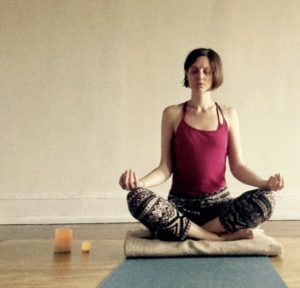 If you’re new to meditation, or looking to change up your practice, there are several popular meditation methods out there to add variety to your daily routines. Healthy habits are important, especially in quarantine!
If you’re new to meditation, or looking to change up your practice, there are several popular meditation methods out there to add variety to your daily routines. Healthy habits are important, especially in quarantine!
The following methods suggested by Yoga District teachers may be more approachable for many of us in this stressful time. They are structured, embrace a healthy point of focus for the mind, and allow you to cope with everyday challenges of life right now.
RAIN Method
The RAIN (Recognize, Allow, Investigate, Nurture) Method popularized by Tara Brach, a well-known mindfulness and meditation expert (2). This method has four steps:
- 1. Recognize – acknowledge that a thought took you away from meditation, and acknowledge the feelings that accompany the thought.
- 2. Allow – allow yourself to have thoughts and feelings without judgement; permit these feelings and thoughts to exist within you.They are part of being human.
- 3. Investigate – look with curiosity to see what is going on in the mind, as opposed to seeking an answer about why or how.
- 4. Nurture – embrace and welcome this feeling or thought with love and acceptance so that it can exist without attachment.
Moving Meditations
During a time of stress, the traditional seated meditation can be even more difficult. Moving meditations can be a wonderful way to embrace mindfulness without the stress of being cooped up. This style of meditation facilitates awareness of the body and breath through simple movements (3).
Blythe regularly incorporated moving meditations into her life prior to quarantine and Jess enjoys them barefoot in a quiet space. Blythe finds them to be active yet calming enough to destress and be centered. For Jess, focusing on the ground beneath the feet and bringing the mind into the moment can be a very powerful tool for meditation. This is particularly true during a time when so many of us feel disrupted.
Noting Meditations
Noting meditation is a powerful technique for those who feel consumed by thoughts or who struggle to remain fully present in the meditation (4). It consists of applying a simple one-word label to a sensation or experience in order to acknowledge its existence. For example, if a sound occurs, the practitioner might mentally say, “hearing” and repeat the word until the distraction disappears.
Jess practices noting in her meditations regularly because she can notice in that moment which sensations and feelings she is experiencing in her body. Noting these feelings can take power away from challenging emotions, reminding us that they are temporary. This practice can help us control how we notice and react to them. Jess explains, “Anytime I notice an icky feeling, I try to take a moment to go inside, pay careful attention, and notice exactly what sensations in my body I’m experiencing as worry, anxiety, or grief.”
Embracing the Meditation Practice
Above all, meditation is an evolving practice, not a skill to be mastered. Progress and its associated benefits are felt as a result of effort, not as a marker of success. The act of attempting to meditate itself communicates to the mind and the body that they can slow down, work together, and embrace the present moment.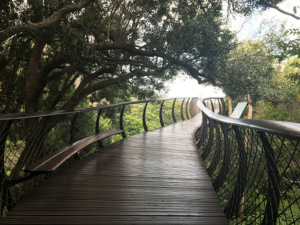
Ultimately, meditation is an exercise in acceptance. Accepting the thoughts, the challenges, and the practice are all parts of the experience. As humans, especially in this day and age, we are prone to experience racing minds and tightly-wound thoughts. That is perfectly okay. Meditation is not about fighting reality. It is about accepting it and allowing it to exist without allowing it to blow you off course. This may be the perfect time to give meditation a try. Slow down, pick a practice, and just be.
Sources
- Meditation Benefits, https://www.healthline.com/nutrition/12-benefits-of-meditation
- Tara Brach and the RAIN Method, www.tarabrach.com/rain/
- Moving Meditation, https://www.yogapedia.com/definition/10629/moving-meditation
- Noting Meditation, https://www.insightmeditationcenter.org/books-articles/mental-noting/

